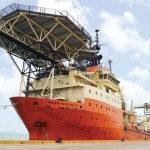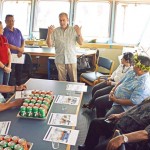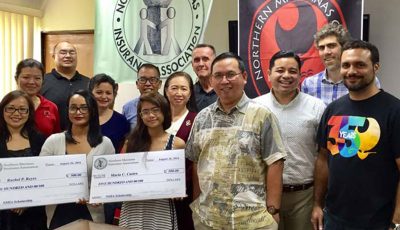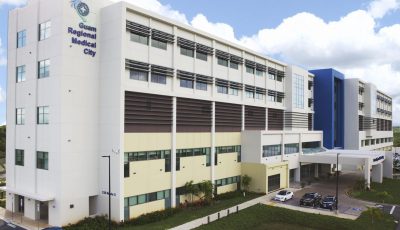ATISA comes ashore today
- The cable ship Responder is docked at the Charlie Dock of Saipan. Other photo shows Docomo Pacific chief executive officer Jonathan Kriegel, center, explaining to Lt. Gov. Victor B. Hocog, far right, Gov. Ralph DLG Torres, second from right, and first lady Diann Torres, third from right, what ATISA has in store for the CNMI. (Erwin Encinares)
Docomo Pacific’s latest project called ATISA—which aims to tie the Marianas together in one undersea fiber optic network cable—is expected to wade ashore today.
According to Docomo Pacific chief executive officer Jonathan Kriegel, the new fiber optic cable, after preparations that started in late 2016, is expected to come up to shore today, and the telecommunications firm will be hosting a landing ceremony at the Aquarius Beach Tower.
ATISA is Docomo Pacific’s fiber-optic cable system that comes in at 175 miles in length. ATISA would connect the islands of Guam, Saipan, Rota, and Tinian to the rest of the world, bringing with it a whole new world of connection speeds.
Expected to be up and running by August 2017, ATISA is expected to arrive on Tinian shores by next week and on Rota the following week before testing ATISA for eight additional weeks.
“One of the key things that we have watched in this process is to make sure that as we lay ATISA, we do it in a way that is not disruptive,” said Kriegel, sharing that Tinian’s cable was the most challenging.
Before having its own marine cable, Docomo Pacific used to piggyback on the marine cable of its main competitor, IT&E.
ATISA’s scope covers improved mobile, television, internet, and phone connection services. Being able to finally offer 4G LTE data on island, bigger data allowances, and improved coverage across the islands, ATISA is touted as “bringing unimaginable speeds” of connectivity to Guam and the rest of the world.
The cable is being laid by the ship Responder, a multi-shore offshore construction and cable laying vessel that has an extensive global track record for both telecom and power cable installation. Docomo’s contractor, NEC Corp., along with subcontractor Korea Telecom or KT, is handling the operation.
According to Kriegel, the total amount of data that Docomo Pacific uses and sends back and forth to the U.S. from the CNMI and Guam everyday is only about 40 gigabits.
“On the day that we [start up ATISA], we are going to have seven times the capacity than all of Docomo Pacific requires. The CNMI would have a lot of capacity starting from day one,” he said.
“No more buffering,” he added.
Kriegel mentioned that three wavelengths of 100 gigabits would be opened once ATISA is up and running. This means that, altogether, data of up to 100 gigabits may travel in three channels that could entertain 100 gigabits of data each, resulting in faster internet connection speeds as well as better mobile connections.
“This cable would give us the capacity to launch all of the services we have on Guam here in the CNMI as well. That means we would have LTE 4G networks on Saipan, Tinian, and Rota; we would launch the Tivo cable television system we just launched in Guam here as well; and we would launch faster internet speeds,” he said.
Kriegel told the media that Guam’s 100 megabit internet offering would be available on Saipan, Tinian, and Rota as well.





























